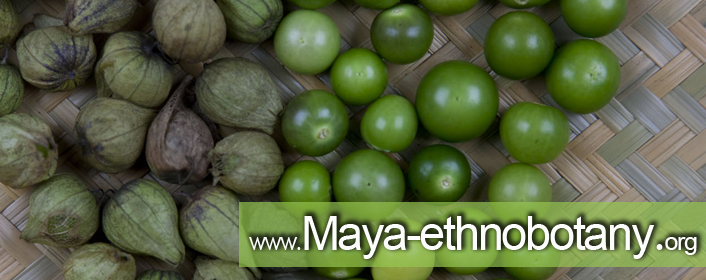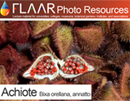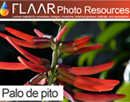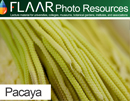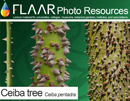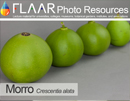When time and funding permit, each flower (each plant species) will have its own page, and its own PDF, and eventually its own PPT so that professors and students have plenty of material on Guatemala (and Honduras, etc) to study.
Heliconia adflexa, Coban, Guatemala, Hotel Monja Blanca, FLAAR, by Nicholas Hellmuth
This space is for flowers
we have recently found and photographed.
|
| Share
|
| Colubrina arborescens, medicinal plant, tannin for Mayan hides |
|
Colubrina arborescens tree discovered in Parque Nacional Yaxha Nakum Naranjo While on the Rio Ixtinto, courtesy of a lancha kindly provided by the Yaxha Nakum Naranjo park administrators (CONAP and IDAEH) we discovered a tree species known for other parts of Mesoamerica but not yet documented for Tikal. This is good evidence that the Yaxha national park has eco-systems not (yet) found in the remarkable Tikal park. Colubrina arborescens (P. Mill.) Sarg., Family Rhamnaceae, is called Greenheart or snakebark. Costex is a word for it that no one mentioned when we asked what tree this was. Also called coxte or guayabillo. Names in Yucatan peninsula are: pimienta ché (español-maya); chak buuj lu'um che', cakte' kajum (maya). (Flora de la Peninsula de Yucatan, www.cicy.mx). But this web site lists not one single use. Multiple uses of Colubrina arborescens plants Balick et al (2000: 111) list it as BEV, CNST, MED, and PRD (but without indicating what that product is). Construction is general since if you are desperate you will use whatever wood is available. BEV is very interesting. Can’t help but notice that tannin is not included in this Belize usage list. The primary question is whether these uses are for lower Mesoamerica or for Belize, and if for Belize whether for the Q’eqchi’ Mayan people or other people. So one purpose of this FLAAR report is to raise awareness of the need to document edible (drinkable) and utilitarian plants but with specific details. Plus the present FLAAR report is dedicated to raising awareness that the Parque Nacional Yaxha Nakum Naranjo is a great place to undertake research on eco-systems, plants, mushrooms, lichens, birds, animals, reptiles, insects and all other aspects of this Neotropical part of the world. Lundell lists Colubrina heteroneura and Colubrina reclinata in his index (1937: 228). Colubrina reclinata “Its leaves and wood are said to impart a yellow color to water.” In his The Vegetation of Peten, in the section Northern Peten, for the family Rhamnaceae he lists only Krugiodendron ferreum (Vahl) Urban. Quiebra hacha, for Uaxactun (1937: 68). I learned about quiebra hacha when I lived and worked at Tikal for 12 months (1965-1966) plus when I lived and worked at Yaxha in the 1970’s. Lundell and his colleagues collected mainly in other parts of Guatemala than Yaxha, though he does have many plants in his list from roads leading into Yaxha in the 1930’s. Colubrina arborescens is not present in Vol. 24, Part VI of Fieldiana Botany monograph series (Standley and Steyermark 1949: 282). Cook does not list Colubrina arborescens in her excellent coverage of the Lacandon (Chiapas, Mexico). Pennington and Sarukhan also do not include it for trees of Mexico. And in the 54 years I have been in the Mayan areas, no one has ever mentioned this tree to me. We only found it because it was physically next to bright red flowers of another bush that we were photographing along the shore of the Rio Ixtinto. The flowers of Colubrina arborescens do not stand out as noticeable until you are literally a few inches away from them. We moved the boat to the shore and I stood up to photograph down onto the flowering areas of the branches of the Colubrina arborescens tree. Uses of Colubrina arborescens http://tropical.theferns.info/viewtropical.php?id=Colubrina+arborescens
Colubrina arborescens for tannin Tannin is used to cure hides to make leather. The Classic Maya had two species of deer and five species of felines (of which they used a lot of jaguar hides and probably occasionally puma hides). The other three felines are rather small but their hides were certainly still used (margay, ocelot and jaguarundi). Dictionary of Trees, Volume 2: South America: Nomenclature, Taxonomy and Ecology by M. M. Grandtner and Julien Chevrette say it contains tannin, alkaloids and saponins; and has seeds for necklaces and other ornaments (page 151). Helps local Bees produce nicely flavored Honey Apiculture: The species is considered a honey plant, furnishing both nectar and pollen to honeybees (Apis mellifera L.) The plant attracts abundant insects including bees, wasps, butterflies, and diurnal moths, which in turn provide food for warblers (Dendroica spp.), gnatchers (Polioptila spp.), kingbirds (Tyrannus spp.), and vireos (Vireo spp.). The leaves of Colubrina arborescens have useful chemicals Has potential as shade tree for cacao, both for shade and for providing leaf mass along the ground. These benefits are mentioned in various articles.
The specimen we found along the Rio Ixtinto was more like a bush or young tree, as most plants along the bank of any Peten river have to survive the rising and falling of the water level, plus the soil at the edge of rivers and lakes tends to erode and fall into the water (bringing the plants with it). So now we have another tree, present at Yaxha but not yet listed for Tikal Surely Colubrina arborescens grows somewhere in the extensive Parque Nacional Tikal but we have not yet found it in Lundell’s list of plants in northern Peten (a regional list within his 1937 monograph, which is mostly on La Libertad and savanna areas of Peten). Perhaps this tree is not in the Tikal area because there is no free flowing river like the Rio Ixtinto at Yaxha. Although the Rio Holmul passes through the Tikal park area, it is just a series of occasional pools of water (as is the same “river” along the edge of Nakum and later near Naranjo). This “river” is dry most years, in fact in 2018 it was still not flowing even during August through December; and same in January 2019: just a series of pools separated by dry river mud. But all the native Guadua bamboo were happily growing along the several kilometers that we have inspected so far (Nakum and westward within the park; we still need to have time and funding to study the Nakum-to-Naranjo portion of the Rio Holmul). Although the Rio Ixtinto does not have very fast current, it was a functional stream every month that we were at Yaxha during 2018 (August through December). I estimate that Colubrina arborescens should be found along streams that are tributaries of the larger Rio de la Pasion, though modern pollution and population growth are causing most river bank vegetation to be totally chopped down and exterminated. So it’s great that all of us who worked starting in the 1970’s and through the 1990’s until the park was fully established. Since Parque Nacional Yaxha Nakum Naranjo has eco-systems not in other adjacent parks. And since Yaxha, Nakum, Naranjo park has most of the eco-systems of much of the rest of Peten (except for pine forests and savanna areas), we high recommend the Yaxha Nakum Naranjo eco-systems as a fruitful place for botanists, ecologists, and students to visit to do their research, theses, and dissertations. Brief Introductory Suggested Further Reading on Colubrina arborescens M. M. Grandtner and Julien Chevrette PDF, Articles, Books on Colubrina arborescens
Suggested webpages with photos and information on Colubrina arborescens
www.backyardnature.net/mexnat/coffeeco.htm
www.worldagroforestry.org/treedb/AFTPDFS/Colubrina_arborescens.PDF
www.theplantlist.org/tpl1.1/record/kew-2731457
www.freshfromflorida.com/content/download/13736/233883/Colubrina%20arborescens.pdf
http://tropical.theferns.info/viewtropical.php?id=Colubrina+arborescens
First posted, February 2019 |
Parque Nacional Yaxha, Nakum and Naranjo
Carnivorous Plants
Plants of Municipio de Livingston, Izabal
- Acrostichum danaeifolium, giant leather ferns
- Bellucia Pentamera
- Bibliography on Grias cauliflora
- Bibliography on Licania platypus
- Bibliography on Mangle negro (Avicennia germinans) L.
- Bibliography on Montriacardia arborescens
- Bibliography on Typha domingensis and Thypha latifolia
- Conocarpus erectus, white mangrove
- Edible Wetlands Plants, Hotel Tortugal
- Heliconia latispatha
- Heliconia wagneriana
- Manicaria saccifera Confra palm
- Neotropical trees of Guatemala need protection
- Nymphoides indica, waterlily flowers
- Pachira aquatica, zapoton
- Bibliography on Pithecellobium Mart., Neotropical trees of Mesoamerica
Ecosystems, Wetlands Aquatic Plants
Smartphone Camera Reviews
Bushes and small trees
Fungi and Lichens
Orchids
- Bibliography Bletia purpurea, aquatic orchid
- Bibliography, Epidendrum radicans
- Bibliography on Habenaria Orchids from Yaxha
- Bibliography, Lycaste virginalis var. alba.
- Bibliography, Macroclinium bicolor
- Bibliography, Prosthechea cochleata
- Bibliography Sobralia macrantha, Lirio de San Juan
- Bibliography, Sobralia xantholeuca
- Bibliography on Terrestrial shade orchids from Guatemala
- Bibliography on Terrestrial sunny orchids from Guatemala
Botanical Terms
Maya and Aztec flavorings for cacao, cocoa, chocolate
- Achiote, Bixa orellana
- Bibliography on Achiote, Bixa orellana
- Bibliography on Esquisúchil, Bourreria huanita
- Bourreria huanita
- Cassia grandis, bucut
- Chile Chocolate
- Chile Chocolate (Capsicum annuum var accuminatum)
- Chiranthodendron pentadactylon
- Cymbopetalum penduliflorum
- Guazuma ulmifolia
- Haematoxylum brasiletto
- Piper auritum, hoja santa
- Piper species
- Quararibea funebris
- Sterculia apetala, castaño
- Tagetes sp., Marigold
- Talauma, a variant of Magnolia
- Vanilla orchid
- Virola and nutmeg
Cacao, cocoa, chocolate
Consulting cacao & Theobroma species
Tobacco Ingredients of Aztec & Maya
Trees of Mesoamerica
- Bibliography on Acacia dolichostachya, Wild tamarind
- Bibliography, Bellucia costaricensis
- Bibliography, Bucida buceras
- Bibliography on Coccoloba belizensis Standl.
- Bibliography on Cojoba sp. and Cojoba arborea
- Bibliography, Ficus.
- Bibliography on Haematoxylum campechianum and H. brasiletto
- Bibliography on Hibiscus pernambucensis
- Bibliography on Ipomea murucoides
- Bibliography on Lacmellea standleyi, lechemiel
- Bibliography on Leucaena leucocephala
- Bibliography on mangle rojo (Rhizophora mangle)
- Bibliography on Manzanillo, Alseis yucatanensis Standl.
- Bibliography on Matilisguate, Tabebuia rosea
- Mangrove swamp Trees
- Bibliography on Ruagea insignis
- Bibliography on Pterocarpus officinalis
Bombacaceae, Bombacoideae
Tropical Fruits of the Maya
- Avocado Hass
- Bibliography on Coloc, Talisia floresii
- Bibliography, Dichogamy of avocado species
- Bibliography on Guayo, Talisia olivaeformis
- Bibliography on Laetia thamnia, Bakelac
- Bibliography on Maracuyá, Passiflora quadrangularis L.
- Bibliography on Punica granatum L., Granada
- Cashew
- Cuajilote, Parmentiera aculeata
- Granada
- Guanabas and Annonas
- Guava, Guayaba, Psidium guajava L
- Introduction to Papaya
- Nance a fruit of prehispanic Guatemala
- Passion flowers and fruits
- Passion flower, giant fruit
- Talisia floresii, Sapindaceae
- Carica Papaya Bibliography
Tropical Nuts
Spices, condiments, food coloring
Medicinal Plants
- Aristolochia, The largest flower in Guatemala, Bibliography
- Asclepias curassavica, bibliography
- Bibliography on Ciricote, Cordia dodecandra
- Bibliography on Contrahierba, Dorstenia contrajerva
- Bibliography on Falso hibisco, Malvaviscus arboreus
- Bibliography on Huele de noche, Cestrum nocturnum
- Bibliography on Lirio araña, Hymenocallis littoralis
- Bibliography on Roble Prieto, Ehretia tinifolia
- Bibliography, Tithonia diversifolia
- Canak
- Calliandra general info
- Guava, Guayaba
- Magnolia and Taluma
- Mayan medicinal plants
- Piper
- Tecomasuche, Coclospermum vitifolium
- Bibliography on Sufricay, Malmea depressa
- Bibliography on Wigandia urens
Underutilized edible plants
Edible Plants of the Mayan World
- Acacia, subin, bullhorn acacia
- Bibliography, Annona muricata
- Bibliography, Annona purpurea
- Bibliography, Annona reticulata
- Bibliography on Chipilín, Crotalaria longirostrata
- Bibliography on Chirimoya, Annona squamosa
- Bernoullia flammea
- Canna indica, tamale wrap
- Cuchamper, Gonolobus
- Guava, Guayaba
- Bibliography, Gonobolus sp.
- Bibliography, Parmentiera aculeata
- Pacaya palm Chamaedorea tepejilote
- Split leaf philodendron, Monstera deliciosa
Plants and trees used to produce incense
Utilitarian Plants
- Bibliography, Acacia farnesiana
- Bibliography on Aechmea bromeliifolia
- Bibliography on Agave americana
- Bibliography, native Agave species from Guatemala
- Bibliography on Anthurium crassinervium (Jacq.) Schott
- Bibliography on Balsa, Ochroma pyramidale
- Bibliography on Bamboo, Guadua longifolia (E.Fourn) R.W.Pohl
- Bibliography, Crescentia alata
- Bibliography, Crescentia cujete
- Bibliography on Hule, Castilla elastica
- Blepharidium guatemalense, irayol blanco
- Crescentia alata, Crescentia cujete
- Tecomasuche, Coclospermum vitifolium
- Bibliography on Coxte, Colubrina arborescens
- Bibliography on Madre cacao, Gliricidia sepium
- Bibliography on Tillandsia usneoides
